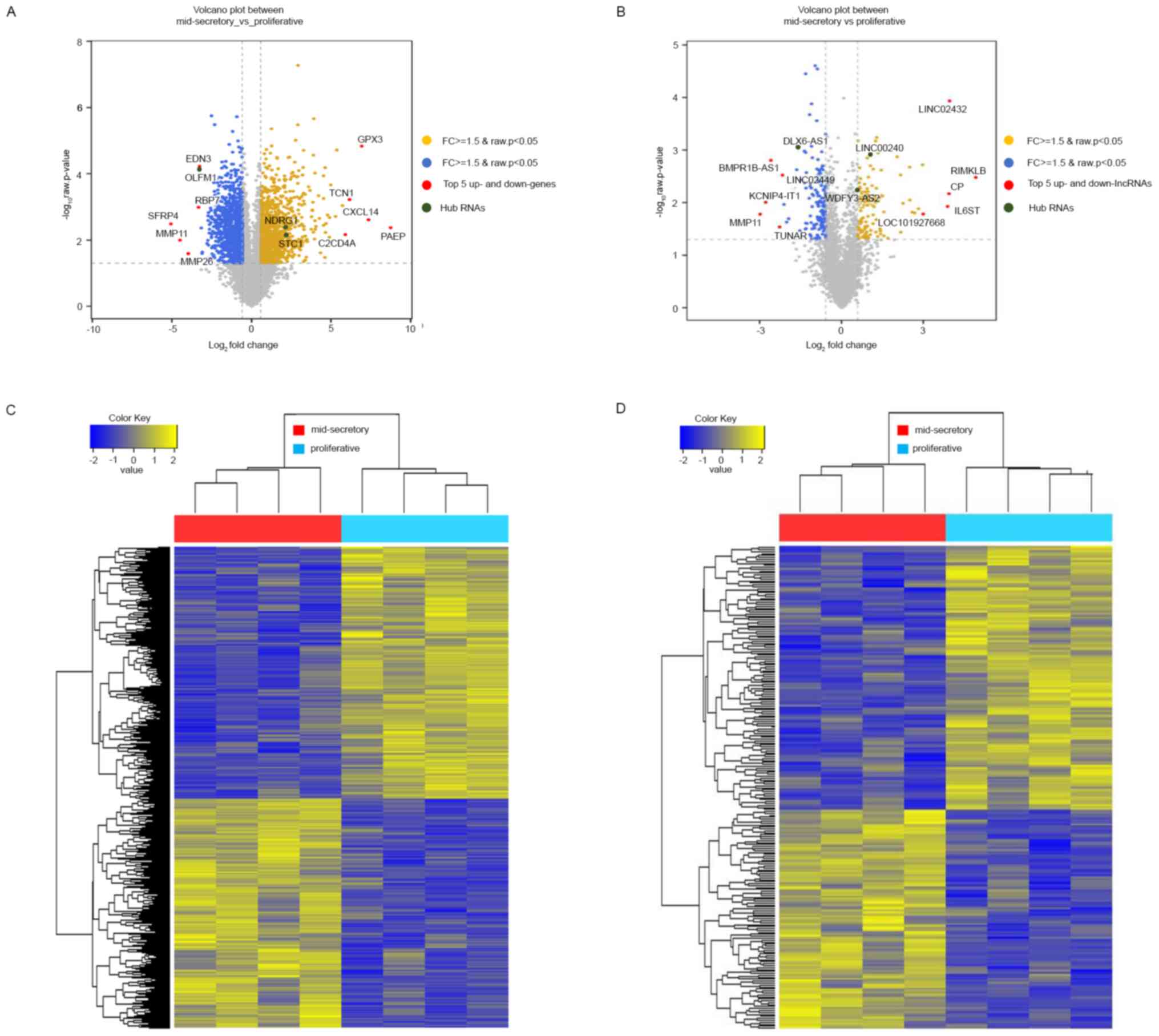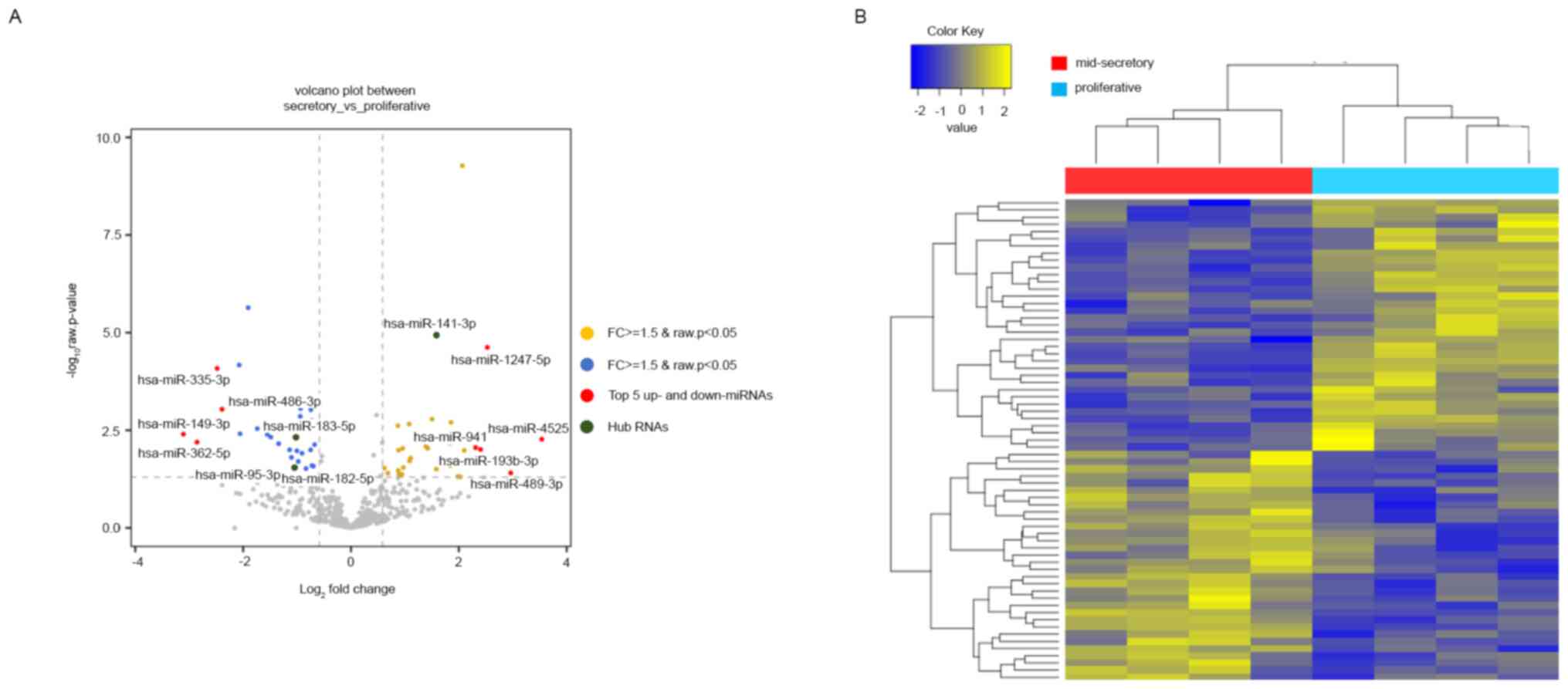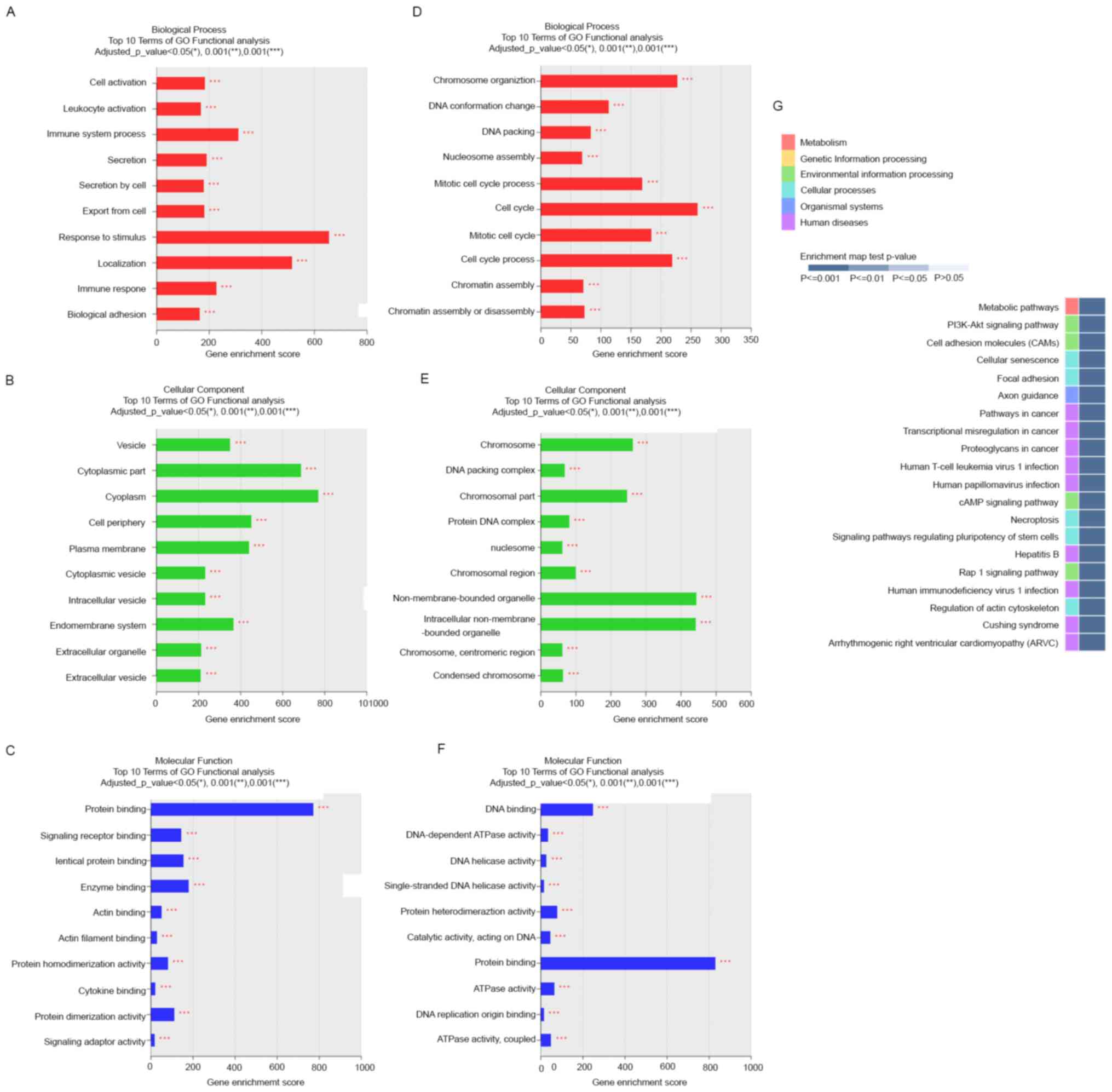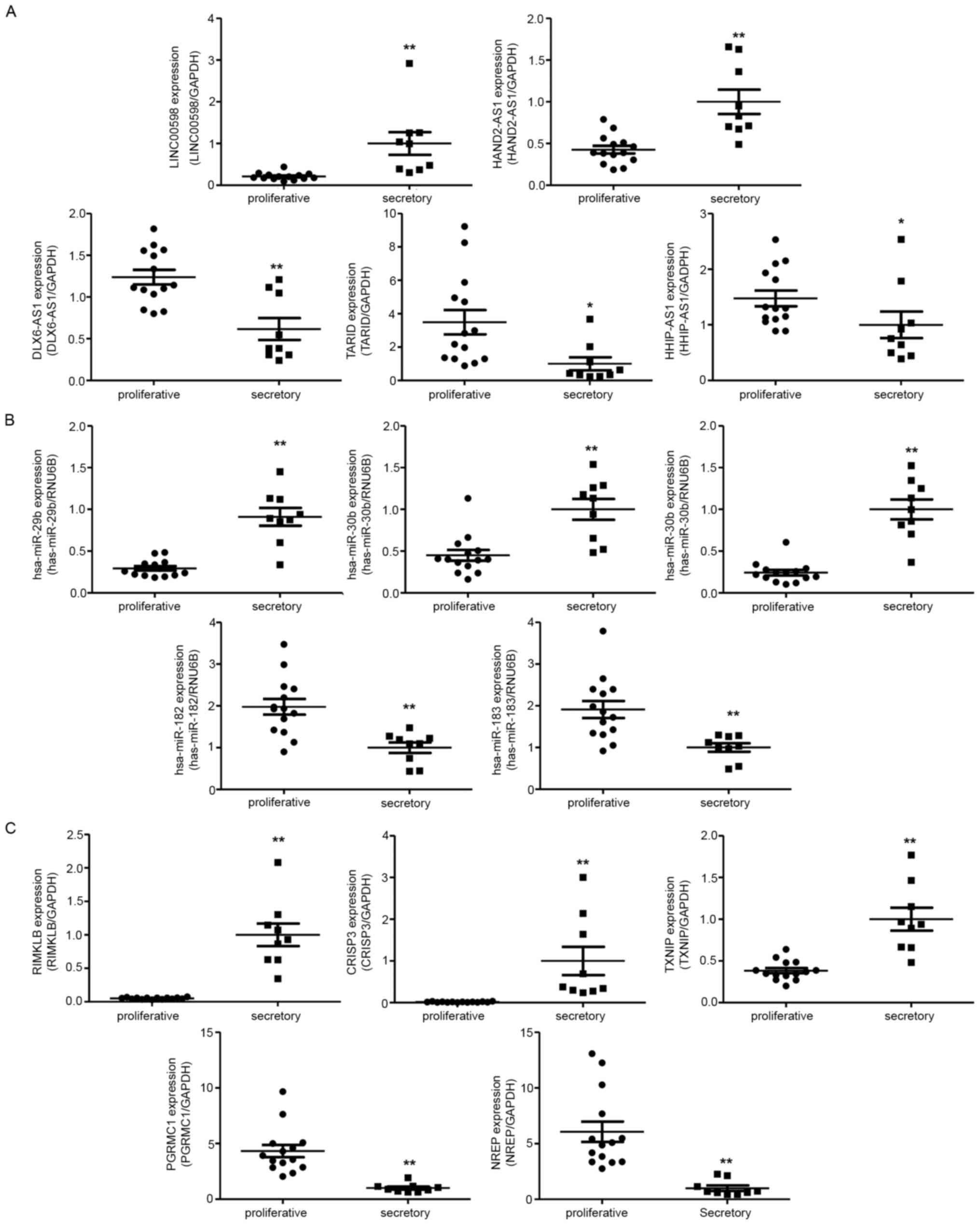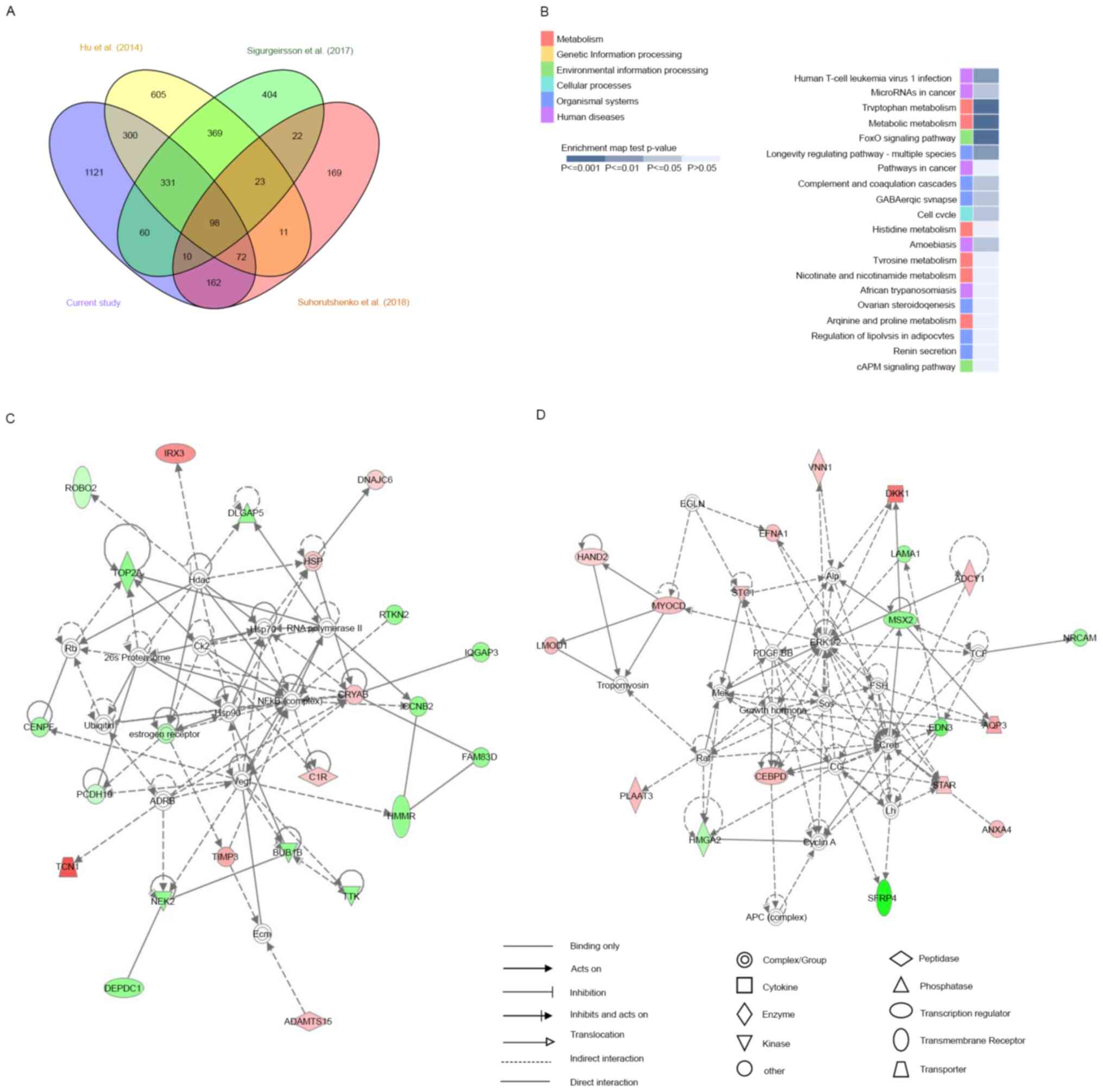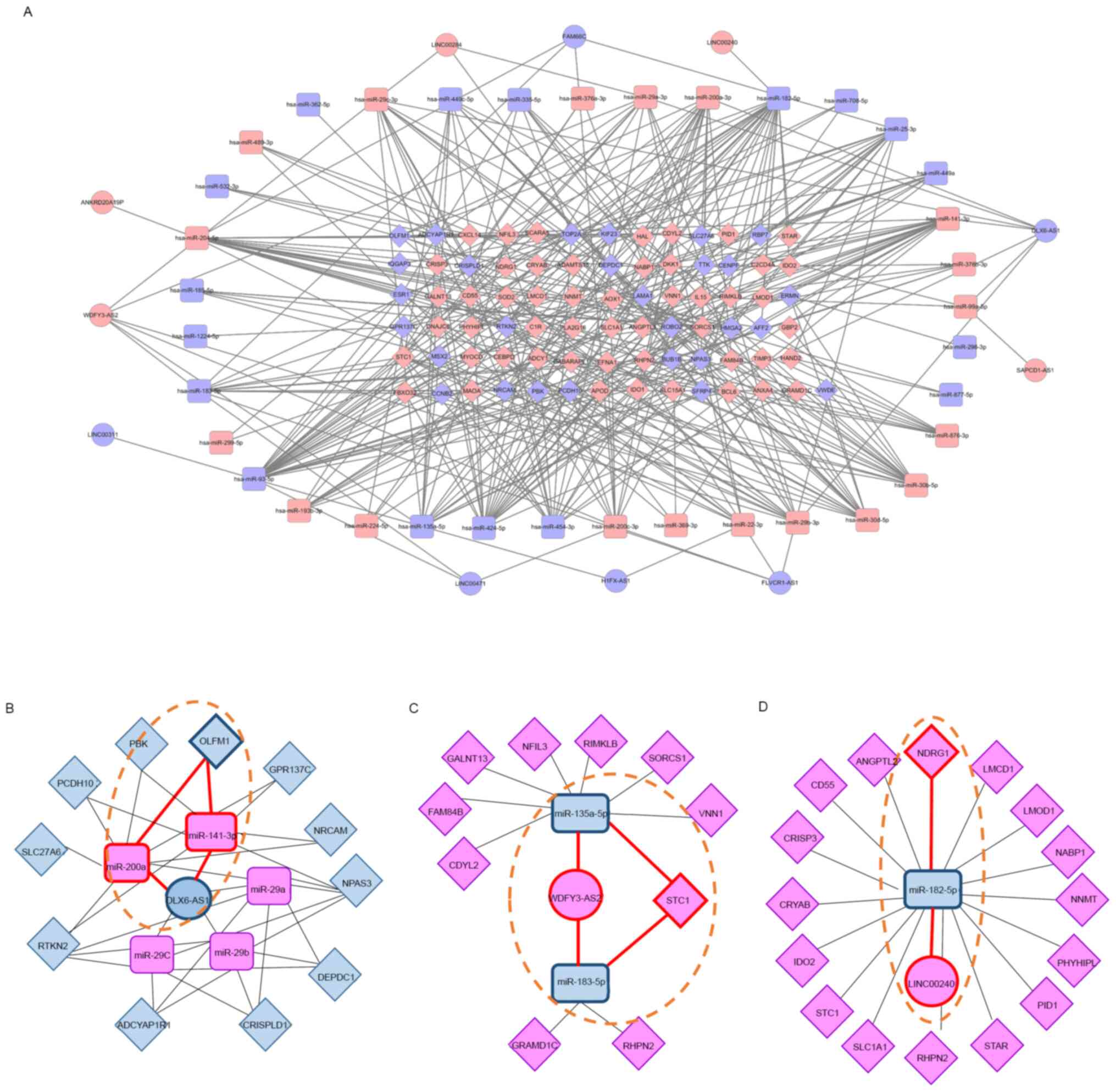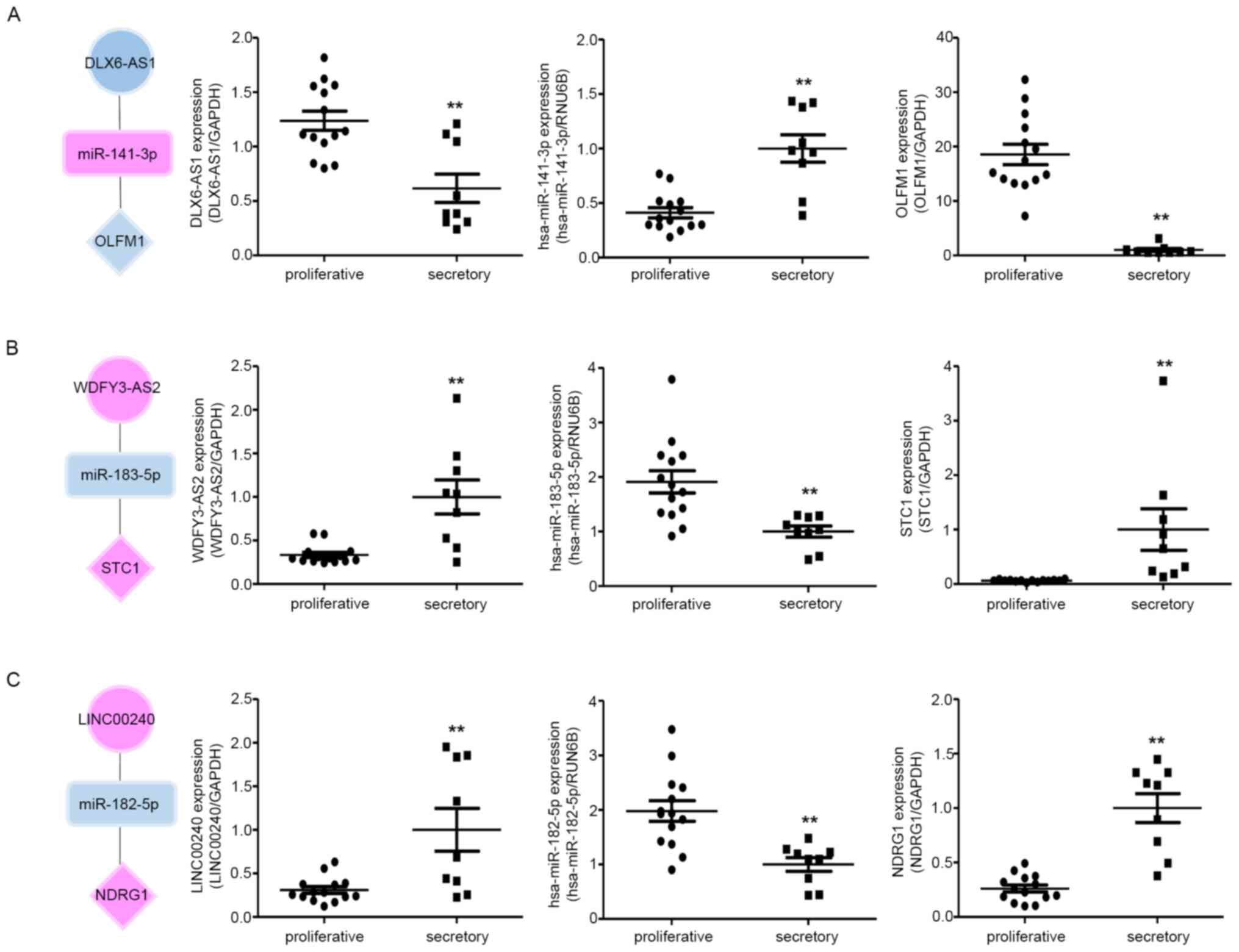|
1
|
Psychoyos A: Hormonal control of
ovoimplantation. Vitam Horm. 31:201–256. 1973.PubMed/NCBI View Article : Google Scholar
|
|
2
|
Simon C, Martin JC and Pellicer A:
Paracrine regulators of implantation. Best Pract Res Clin Obstet
Gynaecol. 14:815–826. 2000.PubMed/NCBI View Article : Google Scholar
|
|
3
|
Aplin JD: The cell biological basis of
human implantation. Best Pract Res Clin Obstet Gynaecol.
14:757–764. 2000.PubMed/NCBI View Article : Google Scholar
|
|
4
|
Cha J, Sun X and Dey SK: Mechanisms of
implantation: Strategies for successful pregnancy. Nat Med.
18:1754–1767. 2012.PubMed/NCBI View Article : Google Scholar
|
|
5
|
Carson DD, Lagow E, Thathiah A, Al-Shami
R, Farach-Carson MC, Vernon M, Yuan L, Fritz MA and Lessey B:
Changes in gene expression during the early to mid-luteal
(receptive phase) transition in human endometrium detected by
high-density microarray screening. Mol Hum Reprod. 8:871–879.
2002.PubMed/NCBI View Article : Google Scholar
|
|
6
|
Kao LC, Tulac S, Lobo S, Imani B, Yang JP,
Germeyer A, Osteen K, Taylor RN, Lessey BA and Guidice LC: Global
gene profiling in human endometrium during the window of
implantation. Endocrinology. 143:2119–2138. 2002.PubMed/NCBI View Article : Google Scholar
|
|
7
|
Borthwick JM, Charnock-Jones DS, Tom BD,
Hull ML, Teirney R, Phillips SC and Smith SK: Determination of the
transcript profile of human endometrium. Mol Hum Reprod. 9:19–33.
2003.PubMed/NCBI View Article : Google Scholar
|
|
8
|
Riesewijk A, Martin J, van Os R,
Horcajadas JA, Polman J, Pellicer A, Mosselman S and Simón C: Gene
expression profiling of human endometrial receptivity on days LH+2
versus LH+7 by microarray technology. Mol Hum Reprod. 9:253–264.
2003.PubMed/NCBI View Article : Google Scholar
|
|
9
|
Mirkin S, Arslan M, Churikov D, Corica A,
Diaz JI, Williams S, Bocca S and Oehninger S: In search of
candidate genes critically expressed in the human endometrium
during the window of implantation. Hum Reprod. 20:2104–2117.
2005.PubMed/NCBI View Article : Google Scholar
|
|
10
|
Hu S, Yao G, Wang Y, Xu H, Ji X, He Y, Zhu
Q, Chen Z and Sun Y: Transcriptomic changes during the
pre-receptive to receptive transition in human endometrium detected
by RNA-Seq. J Clin Endocrinol Metab. 99:E2744–E2753.
2014.PubMed/NCBI View Article : Google Scholar
|
|
11
|
Sigurgeirsson B, Amark H, Jemt A, Ujvari
D, Westgren M, Lundeberg J and Gidlöf S: Comprehensive RNA
sequencing of healthy human endometrium at two time points of the
menstrual cycle. Biol Reprod. 96:24–33. 2017.PubMed/NCBI View Article : Google Scholar
|
|
12
|
Suhorutshenko M, Kukushkina V,
Velthut-Meikas A, Altmäe S, Peters M, Mägi R, Krjutškov K, Koel M,
Codoñer FM, Martinez-Blanch JF, et al: Endometrial receptivity
revisited: Endometrial transcriptome adjusted for tissue cellular
heterogeneity. Hum Reprod. 33:2074–2086. 2018.PubMed/NCBI View Article : Google Scholar
|
|
13
|
Gomez E, Ruiz-Alonso M, Miravet J and
Simon C: Human endometrial transcriptomics: Implications for
embryonic implantation. Cold Spring Harb Perspect Med.
5(a022996)2015.PubMed/NCBI View Article : Google Scholar
|
|
14
|
Yamamura S, Imai-Sumida M, Tanaka Y and
Dahiya R: Interaction and cross-talk between non-coding RNAs. Cell
Mol Life Sci. 75:467–484. 2018.PubMed/NCBI View Article : Google Scholar
|
|
15
|
Guttman M, Amit I, Garber M, French C, Lin
MF, Feldser D, Huarte M, Zuk O, Carey BW, Cassady JP, et al:
Chromatin signature reveals over a thousand highly conserved large
non-coding RNAs in mammals. Nature. 458:223–227. 2009.PubMed/NCBI View Article : Google Scholar
|
|
16
|
Fan LJ, Han HJ, Guan J, Zhang XW, Cui QH,
Shen H and Shi C: Aberrantly expressed long noncoding RNAs in
recurrent implantation failure: A microarray related study. Syst
Biol Reprod Med. 63:269–278. 2017.PubMed/NCBI View Article : Google Scholar
|
|
17
|
Feng C, Shen JM, Lv PP, Jin M, Wang LQ,
Rao JP and Feng L: Construction of implantation failure related
lncRNA-mRNA network and identification of lncRNA biomarkers for
predicting endometrial receptivity. Int J Biol Sci. 14:1361–1377.
2018.PubMed/NCBI View Article : Google Scholar
|
|
18
|
Chen MY, Liao GD, Zhou B, Kang LN, He YM
and Li SW: Genome-wide profiling of long noncoding RNA expression
patterns in women with repeated implantation failure by RNA
sequencing. Reprod Sci. 26:18–25. 2019.PubMed/NCBI View Article : Google Scholar
|
|
19
|
Lim LP, Lau NC, Garrett-Engele P, Grimson
A, Schelter JM, Castle J, Bartel DP, Linsley PS and Johnson JM:
Microarray analysis shows that some microRNAs downregulate large
numbers of target mRNAs. Nature. 433:769–773. 2005.PubMed/NCBI View Article : Google Scholar
|
|
20
|
Friedman RC, Farh KK, Burge CB and Bartel
DP: Most mammalian mRNAs are conserved targets of microRNAs. Genome
Res. 19:92–105. 2009.PubMed/NCBI View Article : Google Scholar
|
|
21
|
Rižner TL: Discovery of biomarkers for
endometrial cancer: Current status and prospects. Expert Rev Mol
Diagn. 16:1315–1336. 2016.PubMed/NCBI View Article : Google Scholar
|
|
22
|
Wilczynski M, Danielska J, Dzieniecka M,
Szymanska B, Wojciechowski M and Malinowski A: Prognostic and
clinical significance of miRNA-205 in endometrioid endometrial
cancer. PLoS One. 11(e0164687)2016.PubMed/NCBI View Article : Google Scholar
|
|
23
|
Bashti O, Noruzinia M, Garshasbi M and
Abtahi M: miR-31 and miR-145 as potential non-invasive regulatory
biomarkers in patients with endometriosis. Cell J.
20(293)2018.PubMed/NCBI View Article : Google Scholar
|
|
24
|
Salmena L, Poliseno L, Tay Y, Kats L and
Pandolfi PP: A ceRNA hypothesis: The Rosetta Stone of a hidden RNA
language? Cell. 146:353–358. 2011.PubMed/NCBI View Article : Google Scholar
|
|
25
|
Noyes RW, Hertig AT and Rock J: Reprint
of: Dating the endometrial biopsy. Fertil Steril. 112 (Suppl
1):e93–e115. 2019.PubMed/NCBI View Article : Google Scholar
|
|
26
|
Pertea M, Kim D, Pertea GM, Leek JT and
Salzberg SL: Transcript-level expression analysis of RNA-seq
experiments with HISAT, StringTie and Ballgown. Nat Protoc.
11:1650–1667. 2016.PubMed/NCBI View Article : Google Scholar
|
|
27
|
Love MI, Huber W and Anders S: Moderated
estimation of fold change and dispersion for RNA-seq data with
DESeq2. Genome Biol. 15(550)2014.PubMed/NCBI View Article : Google Scholar
|
|
28
|
Shannon P, Markiel A, Ozier O, Baliga NS,
Wang JT, Ramage D, Amin N, Schwikowski B and Ideker T: Cytoscape: A
software environment for integrated models of biomolecular
interaction networks. Genome Re. 13:2498–2504. 2003.PubMed/NCBI View Article : Google Scholar
|
|
29
|
Achache H and Revel A: Endometrial
receptivity markers, the journey to successful embryo implantation.
Hum Reprod Update. 12:731–746. 2006.PubMed/NCBI View Article : Google Scholar
|
|
30
|
Altmäe S, Koel M, Võsa U, Adler P,
Suhorutšenko M, Laisk-Podar T, Kukushkina V, Saare M,
Velthut-Meikas A, Krjutškov K, et al: Meta-signature of human
endometrial receptivity: A meta-analysis and validation study of
transcriptomic biomarkers. Sci Rep. 7(10077)2017.PubMed/NCBI View Article : Google Scholar
|
|
31
|
Díaz-Gimeno P, Horcajadas JA,
Martínez-Conejero JA, Esteban FJ, Alamá P, Pellicer A and Simón C:
A genomic diagnostic tool for human endometrial receptivity based
on the transcriptomic signature. Fertil Steril. 95:50–60, 60 e1-15.
2011.PubMed/NCBI View Article : Google Scholar
|
|
32
|
Julkunen M, Koistinen R, Sjöberg J,
Rutanen EM, Wahlström T and Seppälä M: Secretory endometrium
synthesizes placental protein 14. Endocrinology. 118:1782–1786.
1986.PubMed/NCBI View Article : Google Scholar
|
|
33
|
Chan C, Virtanen C, Winegarden NA, Colgan
TJ, Brown TJ and Greenblatt EM: Discovery of biomarkers of
endometrial receptivity through a minimally invasive approach: A
validation study with implications for assisted reproduction.
Fertil Steril. 100:810–817. 2013.PubMed/NCBI View Article : Google Scholar
|
|
34
|
Burmenskaya OV, Bozhenko VK, Smolnikova
VY, Kalinina EA, Korneeva IE, Donnikov AE, Beyk EP, Naumov VA,
Aleksandrova NV, Borovikov PI and Trofimov DY: Transcription
profile analysis of the endometrium revealed molecular markers of
the personalized ‘window of implantation’ during in vitro
fertilization. Gynecol Endocrinol. 33 (Supp1):S22–S27.
2017.PubMed/NCBI View Article : Google Scholar
|
|
35
|
Zhang D, Sun C, Ma C, Dai H and Zhang W:
Data mining of spatial-temporal expression of genes in the human
endometrium during the window of implantation. Reprod Sci.
19:1085–1098. 2012.PubMed/NCBI View Article : Google Scholar
|
|
36
|
Zhang Z, Zhang L, Zhang L, Jia L, Wang P
and Gao Y: Association of Wnt2 and sFRP4 expression in the third
trimester placenta in women with severe preeclampsia. Reprod Sci.
20:981–989. 2013.PubMed/NCBI View Article : Google Scholar
|
|
37
|
Kodithuwakku SP, Ng PY, Liu Y, Ng EH,
Yeung WS, Ho PC and Lee KF: Hormonal regulation of endometrial
olfactomedin expression and its suppressive effect on spheroid
attachment onto endometrial epithelial cells. Hum Reprod.
26:167–175. 2011.PubMed/NCBI View Article : Google Scholar
|
|
38
|
So KH, Kodithuwakku SP, Kottawatta KS, Li
RH, Chiu PC, Cheung AN, Ng EH, Yeung WS and Lee KF: Human chorionic
gonadotropin stimulates spheroid attachment on fallopian tube
epithelial cells through the mitogen-activated protein kinase
pathway and down-regulation of olfactomedin-1. Fertil Steril.
104:474–482. 2015.PubMed/NCBI View Article : Google Scholar
|
|
39
|
Tan Y, Xiao D, Xu Y and Wang C: Long
non-coding RNA DLX6-AS1 is upregulated in preeclampsia and
modulates migration and invasion of trophoblasts through the
miR-376c/GADD45A axis. Exp Cell Res. 370:718–724. 2018.PubMed/NCBI View Article : Google Scholar
|
|
40
|
Li R, He J, Chen X, Ding Y, Wang Y, Long
C, Shen L and Liu X: Mmu-miR-193 is involved in embryo implantation
in mouse uterus by regulating GRB7 gene expression. Reprod Sci.
21:733–742. 2014.PubMed/NCBI View Article : Google Scholar
|
|
41
|
Balaguer N, Moreno I, Herrero M,
Gonzáléz-Monfort M, Vilella F and Simón C: MicroRNA-30d deficiency
during preconception affects endometrial receptivity by decreasing
implantation rates and impairing fetal growth. Am J Obstet Gynecol.
221:46 e1–46 e16. 2019.PubMed/NCBI View Article : Google Scholar
|
|
42
|
Ren JW, Li ZJ and Tu C: MiR-135
post-transcriptionally regulates FOXO1 expression and promotes cell
proliferation in human malignant melanoma cells. Int J Clin Exp
Pathol. 8:6356–6366. 2015.PubMed/NCBI
|
|
43
|
Singh H and Aplin JD: Adhesion molecules
in endometrial epithelium: Tissue integrity and embryo
implantation. J Anat. 215:3–13. 2009.PubMed/NCBI View Article : Google Scholar
|
|
44
|
Kusama K, Yoshie M, Tamura K, Daikoku T,
Takarada T and Tachikawa E: Possible roles of the cAMP-mediators
EPAC and RAP1 in decidualization of rat uterus. Reproduction.
147:897–906. 2014.PubMed/NCBI View Article : Google Scholar
|
|
45
|
Seo JS, Rhie A, Kim J, Lee S, Sohn MH, Kim
CU, Hastie A, Cao H, Yun JY, Kim J, et al: De novo assembly and
phasing of a Korean human genome. Nature. 538:243–247.
2016.PubMed/NCBI View Article : Google Scholar
|
|
46
|
Galkin F, Mamoshina P, Aliper A, de
Magalhaes JP, Gladyshev VN and Zhavoronkov A: Biohorology and
biomarkers of aging: Current state-of-the-art, challenges and
opportunities. Ageing Res Rev. 60(101050)2020.PubMed/NCBI View Article : Google Scholar
|
|
47
|
Gibson DA, Simitsidellis I, Cousins FL,
Critchley HO and Saunders PT: Intracrine androgens enhance
decidualization and modulate expression of human endometrial
receptivity genes. Sci Rep. 6(19970)2016.PubMed/NCBI View Article : Google Scholar
|
|
48
|
Henriquez S, Tapia A, Quezada M, Vargas M,
Cardenas H, Rios M, Salvatierra AM, Croxatto H, Orihuela P,
Zegers-Hochschild F, et al: Deficient expression of monoamine
oxidase A in the endometrium is associated with implantation
failure in women participating as recipients in oocyte donation.
Mol Hum Reprod. 12:749–754. 2006.PubMed/NCBI View Article : Google Scholar
|
|
49
|
Tapia A, Gangi LM, Zegers-Hochschild F,
Balmaceda J, Pommer R, Trejo L, Pacheco IM, Salvatierra AM,
Henríquez S, Quezada M, et al: Differences in the endometrial
transcript profile during the receptive period between women who
were refractory to implantation and those who achieved pregnancy.
Hum Reprod. 23:340–351. 2008.PubMed/NCBI View Article : Google Scholar
|
|
50
|
Li DD, Yin YH, Wu JY, Yang ZQ, Cao H,
Zhang QL, Guo B and Yue ZP: Effects of Ido1 on mouse
decidualization. Mol Biol (Mosk). 49:649–657. 2015.PubMed/NCBI View Article : Google Scholar : (In Russian).
|
|
51
|
Christian M, Zhang X, Schneider-Merck T,
Unterman TG, Gellersen B, White JO and Brosens JJ: Cyclic
AMP-induced forkhead transcription factor, FKHR, cooperates with
CCAAT/enhancer-binding protein beta in differentiating human
endometrial stromal cells. J Biol Chem. 277:20825–20832.
2002.PubMed/NCBI View Article : Google Scholar
|
|
52
|
Kajihara T, Jones M, Fusi L, Takano M,
Feroze-Zaidi F, Pirianov G, Mehmet H, Ishihara O, Higham JM, Lam EW
and Brosens JJ: Differential expression of FOXO1 and FOXO3a confers
resistance to oxidative cell death upon endometrial
decidualization. Mol Endocrinol. 20:2444–2455. 2006.PubMed/NCBI View Article : Google Scholar
|
|
53
|
Labied S, Kajihara T, Madureira PA, Fusi
L, Jones MC, Higham JM, Varshochi R, Francis JM, Zoumpoulidou G,
Essafi A, et al: Progestins regulate the expression and activity of
the forkhead transcription factor FOXO1 in differentiating human
endometrium. Mol Endocrinol. 20:35–44. 2006.PubMed/NCBI View Article : Google Scholar
|
|
54
|
Lehtinen MK, Yuan Z, Boag PR, Yang Y,
Villén J, Becker EB, DiBacco S, de la Iglesia N, Gygi S, Blackwell
TK and Bonni A: A conserved MST-FOXO signaling pathway mediates
oxidative-stress responses and extends life Span. Cell.
125:987–1001. 2006.PubMed/NCBI View Article : Google Scholar
|
|
55
|
Rached MT, Kode A, Xu L, Yoshikawa Y, Paik
JH, Depinho RA and Kousteni S: FoxO1 is a positive regulator of
bone formation by favoring protein synthesis and resistance to
oxidative stress in osteoblasts. Cell Metab. 11:147–160.
2010.PubMed/NCBI View Article : Google Scholar
|
|
56
|
Gellersen B, Brosens IA and Brosens JJ:
Decidualization of the human endometrium: Mechanisms, functions,
and clinical perspectives. Semin Reprod Med. 25:445–453.
2007.PubMed/NCBI View Article : Google Scholar
|
|
57
|
Liu Y, Kodithuwakku SP, Ng PY, Chai J, Ng
EH, Yeung WS, Ho PC and Lee KF: Excessive ovarian stimulation
up-regulates the Wnt-signaling molecule DKK1 in human endometrium
and may affect implantation: An in vitro co-culture study. Hum
Reprod. 25:479–490. 2010.PubMed/NCBI View Article : Google Scholar
|
|
58
|
Daikoku T, Cha J, Sun X, Tranguch S, Xie
H, Fujita T, Hirota Y, Lydon J, DeMayo F, Maxson R and Dey SK:
Conditional deletion of Msx homeobox genes in the uterus inhibits
blastocyst implantation by altering uterine receptivity. Dev Cell.
21:1014–1025. 2011.PubMed/NCBI View Article : Google Scholar
|
|
59
|
Wang X and Yu Q: Endometriosis-related
ceRNA network to identify predictive biomarkers of endometrial
receptivity. Epigenomics. 11:147–167. 2019.PubMed/NCBI View Article : Google Scholar
|
|
60
|
Xu H, Zhou M, Cao Y, Zhang D, Han M, Gao
X, Xu B and Zhang A: Genome-wide analysis of long noncoding RNAs,
microRNAs, and mRNAs forming a competing endogenous RNA network in
repeated implantation failure. Gene. 720(144056)2019.PubMed/NCBI View Article : Google Scholar
|
|
61
|
Fang C, Xu L, He W, Dai J and Sun F: Long
noncoding RNA DLX6-AS1 promotes cell growth and invasiveness in
bladder cancer via modulating the miR-223-HSP90B1 axis. Cell Cycle.
18:3288–3299. 2019.PubMed/NCBI View Article : Google Scholar
|
|
62
|
Wang X, Lin Y and Liu J: Long noncoding
RNA DLX6AS1 promotes proliferation by acting as a ceRNA targeting
miR199a in cervical cancer. Mol Med Rep. 19:1248–1255.
2019.PubMed/NCBI View Article : Google Scholar
|
|
63
|
Guo Q, Sun H, Zheng K, Yin S and Niu J:
Long non-coding RNA DLX6-AS1/miR-141-3p axis regulates osteosarcoma
proliferation, migration and invasion through regulating Rab10. RSC
Adv. 9:33823–33833. 2019.
|
|
64
|
Hawkins SM, Creighton CJ, Han DY, Zariff
A, Anderson ML, Gunaratne PH and Matzuk MM: Functional microRNA
involved in endometriosis. Mol Endocrinol. 25:821–832.
2011.PubMed/NCBI View Article : Google Scholar
|
|
65
|
Liu X, Gao R, Chen X, Zhang H, Zheng A,
Yang D, Ding Y, Wang Y and He J: Possible roles of mmu-miR-141 in
the endometrium of mice in early pregnancy following embryo
implantation. PLoS One. 8(e67382)2013.PubMed/NCBI View Article : Google Scholar
|
|
66
|
Jimenez PT, Mainigi MA, Word RA, Kraus WL
and Mendelson CR: miR-200 regulates endometrial development during
early pregnancy. Mol Endocrinol. 30:977–987. 2016.PubMed/NCBI View Article : Google Scholar
|
|
67
|
Wu XM, Shao XQ, Meng XX, Zhang XN, Zhu L,
Liu SX, Lin J and Xiao HS: Genome-wide analysis of microRNA and
mRNA expression signatures in hydroxycamptothecin-resistant gastric
cancer cells. Acta Pharmacol Sin. 32:259–269. 2011.PubMed/NCBI View Article : Google Scholar
|
|
68
|
Kottawatta KS, So KH, Kodithuwakku SP, Ng
EH, Yeung WS and Lee KF: MicroRNA-212 regulates the expression of
olfactomedin 1 and C-terminal binding protein 1 in human
endometrial epithelial cells to enhance spheroid attachment in
vitro. Biol Reprod. 93(109)2015.PubMed/NCBI View Article : Google Scholar
|
|
69
|
Franco-Murillo Y, Miranda-Rodríguez JA,
Rendón-Huerta E, Montaño LF, Cornejo GV, Gómez LP, Valdez-Morales
FJ, Gonzalez-Sanchez I and Cerbón M: Unremitting cell proliferation
in the secretory phase of eutopic endometriosis: Involvement of
pAkt and pGSK3β. Reprod Sci. 22:502–510. 2015.PubMed/NCBI View Article : Google Scholar
|
|
70
|
Li W, Ma S, Bai X, Pan W, Ai L and Tan W:
Long noncoding RNA WDFY3-AS2 suppresses tumor progression by acting
as a competing endogenous RNA of microRNA-18a in ovarian cancer. J
Cell Physiol. 235:1141–1154. 2020.PubMed/NCBI View Article : Google Scholar
|
|
71
|
Zhang Q, Guan F, Fan T, Li S, Ma S, Zhang
Y, Guo W and Liu H: LncRNA WDFY3-AS2 suppresses proliferation and
invasion in oesophageal squamous cell carcinoma by regulating
miR-2355-5p/SOCS2 axis. J Cell Mol Med. 24:8206–8220.
2020.PubMed/NCBI View Article : Google Scholar
|
|
72
|
Wu F, Zhao Z, Chai R, Liu Y, Wang K, Wang
Z, Li G, Huang R, Jiang H and Zhang K: Expression profile analysis
of antisense long non-coding RNA identifies WDFY3-AS2 as a
prognostic biomarker in diffuse glioma. Cancer Cell Int.
18(107)2018.PubMed/NCBI View Article : Google Scholar
|
|
73
|
Wang J, Zhang L, Jiang W, Zhang R, Zhang
B, Silayiding A and Duan X: MicroRNA-135a promotes proliferation,
migration, invasion and induces chemoresistance of endometrial
cancer cells. Eur J Obstet Gynecol Reprod Biol X.
5(100103)2019.PubMed/NCBI View Article : Google Scholar
|
|
74
|
Zeng YB, Liang XH, Zhang GX, Jiang N,
Zhang T, Huang JY, Zhang L and Zeng XC: miRNA-135a promotes
hepatocellular carcinoma cell migration and invasion by targeting
forkhead box O1. Cancer Cell Int. 16(63)2016.PubMed/NCBI View Article : Google Scholar
|
|
75
|
Xiao LJ, Yuan JX, Song XX, Li YC, Hu ZY
and Liu YX: Expression and regulation of stanniocalcin 1 and 2 in
rat uterus during embryo implantation and decidualization.
Reproduction. 131:1137–1149. 2006.PubMed/NCBI View Article : Google Scholar
|
|
76
|
Aghajanova L, Altmae S, Kasvandik S,
Salumets A, Stavreus-Evers A and Giudice LC: Stanniocalcin-1
expression in normal human endometrium and dysregulation in
endometriosis. Fertil Steril. 106:681–691 e1. 2016.PubMed/NCBI View Article : Google Scholar
|
|
77
|
Estella C, Herrer I, Moreno-Moya JM,
Quiñonero A, Martínez S, Pellicer A and Simón C: miRNA signature
and Dicer requirement during human endometrial stromal
decidualization in vitro. PLoS One. 7(e41080)2012.PubMed/NCBI View Article : Google Scholar
|
|
78
|
Zhang L, Quan H, Wang S, Li X and Che X:
MiR-183 promotes growth of non-small cell lung cancer cells through
FoxO1 inhibition. Tumour Biol. 36:8121–8126. 2015.PubMed/NCBI View Article : Google Scholar
|
|
79
|
Akbar R, Ullah K, Rahman TU, Cheng Y, Pang
HY, Jin LY, Wang QJ, Huang HF and Sheng JZ: miR-183-5p regulates
uterine receptivity and enhances embryo implantation. J Mol
Endocrinol. 64:43–52. 2020.PubMed/NCBI View Article : Google Scholar
|
|
80
|
Gao JM, Huang LZ, Huang ZG and He RQ:
Clinical value and potential pathways of miR-183-5p in bladder
cancer: A study based on miRNA-seq data and bioinformatics
analysis. Oncol Lett. 15:5056–5070. 2018.PubMed/NCBI View Article : Google Scholar
|
|
81
|
Li Y, Yan J, Wang Y, Wang C, Zhang C and
Li G: LINC00240 promotes gastric cancer cell proliferation,
migration and EMT via the miR-124-3p/DNMT3B axis. Cell Biochem
Funct. 38:1079–1088. 2020.PubMed/NCBI View Article : Google Scholar
|
|
82
|
Zhang Y, Li X, Zhang J and Liang H:
Natural killer T cell cytotoxic activity in cervical cancer is
facilitated by the LINC00240/microRNA-124-3p/STAT3/MICA axis.
Cancer Lett. 474:63–73. 2020.PubMed/NCBI View Article : Google Scholar
|
|
83
|
Myatt SS, Wang J, Monteiro LJ, Christian
M, Ho KK, Fusi L, Dina RE, Brosens JJ, Ghaem-Maghami S and Lam EW:
Definition of microRNAs that repress expression of the tumor
suppressor gene FOXO1 in endometrial cancer. Cancer Res.
70:367–377. 2010.PubMed/NCBI View Article : Google Scholar
|
|
84
|
Meng N, Yang Q, He Y, Gu WW, Gu Y, Zhen XX
and Wang J, Zhang X, Sun ZG and Wang J: Decreased NDRG1 expression
is associated with pregnancy loss in mice and attenuates the in
vitro decidualization of endometrial stromal cells. Mol Reprod Dev.
86:1210–1223. 2019.PubMed/NCBI View Article : Google Scholar
|















